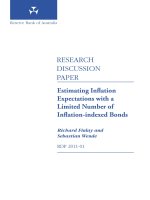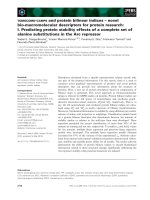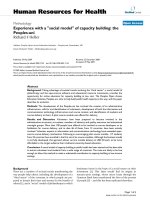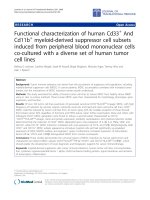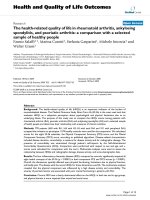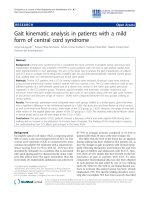Efficient texture synthesis with a small set of tiles
Bạn đang xem bản rút gọn của tài liệu. Xem và tải ngay bản đầy đủ của tài liệu tại đây (5.36 MB, 70 trang )
EFFICIENT TEXTURE SYNTHESIS WITH
A SMALL SET OF TILES
WEN CONG HUA
NATIONAL UNIVERSITY OF SINGPORE
2004
EFFICIENT TEXTURE SYNTHESIS WITH
A SMALL SET OF TILES
WEN CONG HUA
(B.S. in Math., Shandong University, China)
A THSIS SUBMITTED
FOR THE DEGREE OF MASTER OF SCIENCE
DEPARTMENT OF COMPUTER SCIENCE
NATIONAL UNIVERSITY OF SINGAPORE
2004
Acknowledgement
First and foremost, I would like to express my gratitude especially to my supervisors:
•
A/P Tan Tiow Seng, for valuable guidance and for pushing the project ahead.
I have learned from him both the research philosophy and the attitude to life.
•
Dr. Xu Shu Hong, for his continuous support and encouragement. Without his
support and kindness, I could not fulfill this project.
My immense gratitude goes to my parents and sisters. It is your loves that support me
to tackle the difficulties in life and study. I also want to thank all my colleagues in
graphics lab of the School of Computing, and student lab of IHPC.
Special thanks go to all my friends, especially Jin Xingang, Zhang Xinyu, Chen Xin
and Ji Liping who kindly help me when I am in difficulty. I am grateful for your
warmhearted assistance and continuous comfort.
Last but not least, I would like to thank Institute of High Performance Computing and
National University of Singapore for providing me scholarship for this project.
i
Efficient Texture Synthesis with a Small Set of Tiles
Abstract
Time efficiency and visual effect demand effective synthesis techniques to real time
synthesize textures with the same statistical distribution of the texture primitives as
the example. This paper presents an approach to generate, from an input texture, a set
of small textures that can be tiled to synthesize large textures. Such a small set can be
useful in, for example, real-time graphics applications to texture any large area
realistically and efficiently while utilizing small amount of texture memory. We apply
cutting curve to the large space to eliminate the line artifacts. The introduction of new
image patch in each tile makes the texture information diverse. The new tile
combination rule based on the tile indices combines the small tiles without artifacts
and creates a stochastic distribution of the tiles. Our approach is interesting in its
ability to generate a small number of tiles that embed many more texture patterns as
compared to previous approaches. This feature of a small tile set can avoid generating
highly repetitive patterns in synthesized textures. This and its attempt to preserve
consistent local features of the synthesized textures are examined in our experiments
with input textures of stochastic, semi-structured and structured nature. Our approach
performs well in general and is particularly superior to previous work for input
textures of stochastic and semi-structured nature.
Keywords: texture synthesis, image tiling, cutting-path, cutting-curve, Wang tile
ii
Efficient Texture Synthesis with a Small Set of Tiles
Contents
Acknowledgement…………………………………………………………………...i
Abstract……………………………….…………………………………..……….…ii
Contents………………………….…………………………………..……………....iii
List of Figures…………………………….………………………..………………...v
1. Introduction...………………………………………………………..…….….…...1
1.1 Background………………………………………………….………….….….….1
1.2 Problem Statement.…………………………………………….……….…..….....2
1.3 Main Contributions..…..………………………………………….…….…..….....3
1.4 Tiling Scheme Overview..……………………………………………..…..…..…5
1.5 Outline of this Thesis…………………………………………….…….....….…...6
2. Previous Works……..………………………………………………….…..……...7
2.1 Synthesis Algorithm Classification……………………………….……….…...….7
2.2 Statistical Sampling Methods……………………………………….…….…….....9
2.2.1 Non-parametric Method..…………………………………………….……...10
2.2.2 Cutting Path Technique.…………………………………………….…….....12
2.3 Procedural Method….………………………………………………….………...14
2.3.1 Wang Tile Approach..…………………………………………….…............15
3. Tile Generation…………………………………………..……………….………18
3.1 Constructing a Tile……………………………….………………………………18
3.2 Cutting Path and Cutting Curve………………………………….………………19
3.3 Cutting Curve from a Graph.………………………………………….…………21
iii
Efficient Texture Synthesis with a Small Set of Tiles
4. Tile Set Formation…………………...……………………….………...………..26
4.1 Sets of 1, 4, and 8 tiles………………....……………………….…………..…....26
4.2 Sets of 16 and 32 tiles……….…….....…………………………………..………27
4.3 Sets of 36 and 72 tiles...……………………………………………………….....31
5. Experimental Results………………………………………………………….....34
5.1 Tiling Process Overview…………..…………………………………..…………35
5.2 Synthesized Results……………… …………………………….……..…………36
5.2.1 Stochastic Texture Samples..……………………………….…….….………36
5.2.2 Semi-structured Texture Samples…………………………………………...40
5.2.3 Structured Texture Samples..……………………………….……..………...43
5.2.4 Result Comparison…………………………………………………..……....46
5.2.5 Multiple Source Images…………………………………….…….………….51
5.3 Limitations and Solutions……………………………………….……..…………52
6. Conclusion……………………………………………………….………..………55
6.1 Scheme Summary…………………………………………...….………..……….55
6.2 Future Work.…………………………………….……………………..………...56
References……………………..………………………….……………..…………..59
iv
Efficient Texture Synthesis with a Small Set of Tiles
List of Figures
Figure 1.1 Schematic showing the tiling approach.…………………………....……...6
Figure 2.1 Texture synthesis algorithm classification……………….…….….....…....9
Figure 2.2 Schematic drawing to show graph formulation……………………......…12
Figure 2.3 Schematic drawing to show graph formulation…………………....…......13
Figure 2.4 Wang Tile generation……….…………………………..………..….…...16
Figure 3.1 Tiling Process with ω-tile……...…….……………………….………......19
Figure 3.2 Schematic drawing to show corner problem…………………….…..…...21
Figure 3.3 Tile generation in our technique……….……………………..….……….22
Figure 3.4 Cutting curve (green) generation in the graph…………………..……….24
Figure 4.1 Sets of ω-tiles of size 4 and size 8…...…………….………..…..…….…27
Figure 4.2 Examples of ω-tile sets obeying properties (1) to (4)…..….……….……31
Figure 5.1 Overview of tiling process in graphics user interface(GUI)..…………....35
Figure 5.2 Texture synthesis results of our ω-tile approach with input of stochastic
pattern…..………………………………………….……….……..……..37
Figure 5.3 Texture synthesis results of our ω-tile approach with input of stochastic
pattern……………………………………………………………….…...38
Figure 5.4 Texture synthesis results of our ω-tile approach with input of stochastic
pattern.…………………………...……………………………....…..…..39
Figure 5.5 Texture synthesis results of our ω-tile approach with input of semistructured pattern.……………………………………………...………...41
Figure 5.6 Texture synthesis results of our ω-tile approach with input of semistructured pattern.………………………………………………...….…..42
Figure 5.7 Texture synthesis results of our ω-tile approach with input of semistructured pattern.………………………………….………..……...…....42
v
Efficient Texture Synthesis with a Small Set of Tiles
Figure 5.8 Texture synthesis results of our ω-tile approach with input of structured
pattern……………………………………...………………..…………....44
Figure 5.9 Texture synthesis results of our ω-tile approach with input of structured
pattern.………………………………………………..…..………............45
Figure 5.10 Comparison of synthesized textures by Wang tiles and ω-tiles…..…….47
Figure 5.11 Visual comparison of two approaches to deal with corner problems..….49
Figure 5.12 Synthesized leaves by tile sets of various size.………….….……….…..50
Figure 5.13 Image plane created by multiple sources…………………….…….……51
Figure 5.14 Unsatisfactory examples………………………………….…….……….53
vi
Chapter 1 Introduction
Chapter 1 Introduction
1.1 Background
Texture synthesis in graphics can be formulated as follows: given an input texture,
synthesize an output one, which is usually different from the input while keeping the
underlying global distribution pattern [Liang01]. For computer graphics, a general use
of texture synthesis is to pre-compute a large texture for mapping to a large area in an
application while only a small sample texture is available. Most of these utilities are
applied during the process of visualizing or rendering large-scale scenes with
homogeneous texture patterns, such as terrains. In visualizing terrains, user often
resorts to synthesizing image plane from samples rather than constructing the entire
geometric model. Another use of texture synthesis is to generate a set of small
textures that can be combined or tiled into large textures during some real time
applications. Keeping many immense images is a burden for visualization
applications. Therefore, user can apply tiling algorithms to texture a large plane from
a tile set in real time speed. This use can avoid the need of physically having a large
texture memory when texturing a large area. This second application is the focus of
this thesis, though our results can be used in the first application.
In the past decade, a wave of algorithms has been explored in texture synthesis. Many
approaches of pixel-based [Heeger95, de.Bonet97, Efros99, Wei00, Ashikhmin01]
can create a great variety of vivid texture patterns through matching parameters of
1
Chapter 1 Introduction
either statistical models or statistical features. However, they are not feasible to real
time applications as they incrementally synthesize pixels in the output image, even
though a lot of techniques have been utilized to speed up pixel sampling. Recently,
researchers propose to synthesize texture with image patches instead of pixels [Xu00,
Efros01, Liang01, Kwatra03, Neubeck03]. Such patch-based methods can
approximately achieve orders of magnitude faster than pixel-based methods. However,
they are not applicable to our focus application, as they do not generate a set of
textures for efficient tiling. On the other hand, the work of Cohen et al. [Cohen03]
demonstrates such a way. Each square tile, called Wang tile (adapted from [Wang65]),
has (conceptual) a color on each of its four sides representing the texture pattern
contributing to that side. In efficiently synthesizing a large texture, one lays Wang
tiles such that the adjacent sides of two Wang tiles have the same color.
1.2 Problem Statement
In general, there are three levels of challenges to generate a set of small tiles from an
input texture S. First, the content of each tile should be seamless as if it was a
continuous part from S. This is generally impossible due to the next challenge of
fitting tiles across their boundaries. Whether the artifacts in each tile can be detected
out of their neighboring textures are determined by our human discrimination ability.
However, the local difference of the textures directly contributes to our discrimination.
Therefore, various techniques have been investigated in the literatures to decrease the
local difference around the discontinuous area in image. In generating a good Wang
tile, a cutting path approach [Efros01] is applied to combine a set of four patches that
2
Chapter 1 Introduction
is randomly selected from S. Second, tiles should fit together seamlessly across their
boundaries in their synthesized textures. As Cohen et al. mentioned, each side of a
Wang tile is coded with a color and only sides of the same color can be adjacent in a
tiling. Third, the synthesized texture should maintain the underlying global
distribution pattern of S. High repetition or high regularity of local features will make
the generated texture plane too artificial to be natural. Therefore, the way of laying the
tiles in the output image will determine the overall visual effect of the created texture
pattern. In Wang tile approach, this is addressed in a set of Wang tiles with at least
two choices of tiles to be used at each tiling step.
1.3 Main Contributions
Our work proposes an alternative approach to address the above three challenges.
Similar to Cohen et al.’s approach, it generates its tiles, called ω-tiles from a set F of
four patches that are extracted from the input sample S. However, it is different in that
each side of an ω-tile has effectively two colors and its interior is obtained from S,
rather than restricted to those of F only. For a tile set of 16 small ω-tiles, we use four
textures to contribute to four corners and 16 other textures to the interiors of the
generated 16 tiles.
Specifically, our approach first addresses the possible seams within a tile by providing
a large search space so as to control seams that result from combining patches in F.
3
Chapter 1 Introduction
A large search space means more pre-processing time needed, but it also generates ωtiles with less prominent seams. A cutting curve technique is applied in the large
space of each tile to eliminate the line seams. Current cutting path methods [Efros01,
Cohen03, Kwatra03] always focus on eliminating the line seams in small rectangular
overlapping regions. Although such a method can find a heuristic solution to adapt the
pixel values among the rectangular overlapping region of the adjacent patches, the
results are often not satisfactory. As the area in which the cut is supposed to lie tends
to be rather small, the leeway in getting seamless transitions is restricted and
boundaries may remain visible [Neubeck03]. Therefore we seek a transition curve in a
lager domain and get a better visual effect.
Second, seams between two ω-tiles lying adjacent to each other are avoided by having
matching two-color sides between them. A subtle consequence of this, in any
synthesized texture, is the result of a junction at the middle of each side of the ω-tile
where four but not necessarily distinct patches of F meet. Such a junction in the
method of Wang tiles appears in the middle of each tile where two cutting paths meet
and at the four corners of each tile where cutting paths start or end. Junctions/corners
must be treated with care, as they are particularly conspicuous to human eyes as found
from experiments in neuroscience; see [Fahle94, Shevelev03]. In comparison, our
approach allows more degree of control of the content at junctions as two of the four
textures at each junction are obtained through careful searching.
Third, our approach achieves good underlying global distribution pattern of S in the
synthesized texture. In the process of constructing each tile, we search for a new patch
4
Chapter 1 Introduction
from the input texture S to replace some parts of the distribution of F. This makes the
tiles embed more texture patterns (20 in the case of Figure 1.1). In contrast, a set of
Wang tiles uses mainly four textures when synthesizing a large texture and thus tends
to generate repetitive patterns in a large texture.
1.4 Tiling Scheme Overview
The key to design an efficient tiling algorithm is laying the tiles in such a way that the
tiles are stochastically located in the image plane and the combination between the
potential neighboring tiles should satisfy combination constraints. Otherwise, the
synthesized image will either produce high repetition pattern or create visible
intensity gap between the small tiles. In our tiling scheme, we first transfer the
distortions from the sides of each tile to its internal area (see Figure 1.1-(a)). Then, we
search a cutting curve in the large overlapping space of the four patches F and the
new image patch selected from the sample to find a new pattern to cover the internal
line seams in each tile (see Figure 1.1-(b)). To minimize the difference of pixel values
between the four patches F and the new image patch, our algorithm can eliminate the
line seams and preserve low difference of the intensities around the cutting curve in
each tile. Like the tile set shown in Figure 1.1-(b), two tiles can be potentially
neighboring only if their edge colors match. Such a constraint can make the tiles fit
together without line seams across their boundaries and create the potential for tiling
the small ω-tiles stochastically as well. Therefore, our tiling scheme not only produces
smooth combination between tiles, but also preserves the image pattern of the input
sample S.
5
Chapter 1 Introduction
(a)
(b)
Figure 1.1 Schematic showing the tiling approach. Four small patches
(represented in red, green, blue and yellow) are chosen from an input texture to
form 16 blocks; an example of a block is shown on the left. An ω-tile (out of 16) of
the same size as a patch is cut from the center of each block. The color at each
corner of an ω-tile indicates the patch of that color that contributes to the corner.
Its interior (shown within weaving closed curve) is obtained through searching the
input texture.
1.5 Outline of this Thesis
This thesis is organized in six chapters discussing various topics related to our tiling
scheme. This chapter introduces the background and main problems of image tiling,
our contributions, and tiling overview. Chapter 2 reviews the related previous works
in texture synthesis. We make a classification of current texture synthesis algorithms.
Then, we review some previous work including the technique of cutting path [Efros01,
Kwatra03] and the approach of Wang tile [Cohen03]. Chapter 3 and Chapter 4
illustrate the tiling process. Chapter 3 addresses the creation of each ω-tile that is
seamless. Chapter 4 presents an approach to generate various small sets of ω-tiles that
can fit together across their boundaries and can synthesize large textures with less
repetitive patterns. Chapter 5 describes the implementation details and results. The
visual effect of the synthesized images verifies the efficiency of our tiling technique.
And Chapter 6 gives the conclusion and discusses the future work.
6
Chapter 2 Previous Works
Chapter 2 Previous Works
Statistical texture synthesis has been investigated for more than a decade. Two main
categories for texture synthesis are procedural methods and statistical sampling
methods. These two approaches are complementary in their strength and weakness. In
this chapter, we first in Section 2.1 give a classification of texture synthesis
algorithms introduced by current literatures. Then, in Section 2.2 we discuss the
statistical sampling method, where we focus on the main characteristics of synthesis
process in non-parametric sampling approach. At the same time, we introduce one key
technique to eliminate the line seams—cutting path technique [Efros01, Kwatra03].
Finally, in Section 2.3 we introduce the procedural methods and focus on discussing
the approach of Wang tile [Cohen03].
2.1 Synthesis Algorithm Classification
In this section, we introduce an overview of the texture synthesis algorithms and bring
forward a classification, which generalizes other authors’ classifications [Tuceryan98,
Xu00, Liang01, Levina02, Kwatra03].
Besides the use of an explicit texture to texture a large area, the texturing algorithms
can be classified as procedural method [Peachey85, Perlin85, Lewis89, Upstill89,
Turk91, Witkin91, Worley96] and statistical sampling method [Heeger95, de.Bonet97,
Portilla99, Zhu00, Efros99]. Procedural method has been proved itself valuable in
7
Chapter 2 Previous Works
texture synthesis, allowing for complex surfaces to be rendered without requiring
image mapping or modeling geometrical details. They can be fast and support
memory efficient texture rendering by not storing the synthesized texture explicitly
but synthesizing them on the fly [Upstill89]. However, most procedural methods are
only specialized emulators of the generative processes of certain types of textures,
such as marbles, seashells, and animal skins. Procedural methods are usually
classified into procedural texturing approach and pattern based texturing approach,
according to whether the algorithms apply patches of samples to define texture
patterns.
Statistical sampling methods can synthesize a wide variety of textures, as long as
appropriate sample textures are provided. But they need great computational cost. The
major problems for statistical sampling methods are: (1) modeling- how to estimate
the stochastic process from a given finite texture sample and (2) sampling- how to
develop an efficient sampling procedure to produce new textures from a given model.
Both the modeling and sampling parts are essential for the success of texture synthesis:
the visual fidelity of generated textures will depend primarily on the accuracy of the
modeling, while the efficiency of the sampling procedure will directly determine the
computational cost of texture generation [Wei00]. From the modeling perspective, the
synthesis algorithms can be classified from the approaches to model texture in
computer graphics: statistical model [Cross83, Chellappa85, Paget99, Parada01] and
feature matching [Heeger95, Portilla99, de. Bonet97, Zhu97, Zhu00]. From the
sampling perspective, the synthesis algorithms can be classified in view of the
characteristics in sampling information from the given image: parametric sampling
8
Chapter 2 Previous Works
[Heeger95, Portilla99, Zhu00, Soatto01, Wang02] and Non-parametric sampling [de.
Bonet97, Efros99, Efros01, Liang01, Neubeck03].
In general, the classification of current texture synthesis algorithms can be illustrated
in Figure 2.1. Both categories are divided into subclasses according to their specific
characteristics in synthesis.
Synthesis Methods
Statistical Sampling
Modeling
Sampling
Procedural Methods
Procedural texturing
Statistical Model
Non-parametric
Features Matching
Parametric
Pattern based
Figure 2.1 Texture synthesis algorithm classification: statistical sampling
methods are classified by the characteristics in modeling and sampling, and
procedural methods are classified by the principle to define texture patterns.
2.2 Statistical Sampling Method
In statistical sampling method, parametrical sampling approach uses a number of
parameters within a compact parametric model to describe a variety of textures and
then sample pixels within the parametric restriction. The computation for such
approach is especially costly. Therefore, the new trend of non-parametric sampling
approach becomes popular in graphics field, which is also closely related to our tiling
technique. From the inspiration of these literatures, we design our scheme to cut the
9
Chapter 2 Previous Works
patch set F from the input sample S to construct new pattern and to eliminate the
seams across the image patches to create small tiles.
2.2.1 Non-parametric Method
Non-parametric sampling method tends to estimate the local conditional probability
density function and synthesizes pixel incrementally. Efros and Leung [Efro99]
introduce the seminal paper that uses the non-parametric sampling method. Given all
its neighbors synthesized, the conditional distribution of each pixel is estimated by
searching the sample image, finding all similar neighborhoods, and then randomly
choosing one among them. The algorithm produces good results for a wide range of
textures, but is terribly slow, as a full search of the input image is required to
synthesize each pixel.
Many variations of their method have been published to speed up and optimize the
original algorithm in different ways [Wei00, Wei01, Ashikhimin01]. These
algorithms sample information from the random fields directly, without constructing
an explicit model for the distribution. Wei and Levoy [Wei00] optimize Efros and
Leung’s algorithm [Efros99] using neighborhood with a fixed shape so that it can
conduct the searching deterministically. Their method (denoted as WL algorithm) can
be accelerated by tree structured vector quantization (TSVQ). They also succeed in
extending their algorithm to arbitrary surface [Wei01]. Ashikhmin [Ashikhmin01]
presents a modification of the WL algorithm to perform better on a particular class of
textures, which consists of identification primitives of irregular but similar patterns,
such as grass, leafs, pebbles, bushes and so on. This method has made a small step
10
Chapter 2 Previous Works
towards patch-based synthesis by greedily extending existing patches whenever
possible, rather than by searching the entire sample texture.
All the pixel-based sampling methods do not perform fast. They usually cost a lot of
memories and computations on determining each pixel value. Thus these algorithms
including accelerated versions are not appropriate to real time applications. Actually
during synthesis process, most pixels have their values totally determined by those
that have been synthesized so far. Thus algorithms do not need to do searching on
each pixel. This is an important reason that researchers develop patch-based sampling
approaches.
Recently, researchers extend the idea of pixel-based synthesis to synthesize image
patches incrementally [Efros01, Liang01, Kwatra03]. They search for the image
patches in the sample by computing the distance of boundary area between the
candidate patch from the sample and those in the output. This method in theory is to
estimate the local conditional Markov Random Field (MRF) density in the
overlapping region of these patches. Soler [Soler02] extends this approach for
synthesizing texture on surfaces. This searching process can control the intensity
gaps between the image patches. However, in most cases the line seams are still
visible. Therefore, the critical problem left is how to eliminate the line seams between
the image patches. For Liang et al.’s algorithm [Liang01], they just apply feathering
technique to blend the pixels in the adjacent areas. In [Efros01] and [Kwatra03], they
seek the cutting path in the overlapping region of the neighboring patches and adapt
the pixel values according to the tracks of the cutting path. This technique is similar as
ours to eliminate the seams between the set F of four patches. However, we seek a
11
Chapter 2 Previous Works
close path, called cutting curve, in a quite large space of each tile. In the following,
we give a brief introduction to the cutting path technique.
2.2.2 Cutting Path Technique
Efros and Freeman [Efros01] present a cutting path technique in image quilting
method. The algorithm uses dynamical programming to choose the minimum cost
path from one end of the overlapping region to the other. The following schematic
figure shows the cutting path in the overlapping region across the two image patches
(see Figure 2.2).
Figure 2.2 Schematic drawing to show graph formulation: the red line showing the
cutting path in the overlap between two patches.
The weight of the node in the graph is the error of the pixel value in two image
patches.
M ( s, A, B) =|| A( s) − B( s ) ||
(2-1)
where A( s ) and B( s ) denotes the value of pixel s in the patch A and B, respectively.
The vertical directional cutting path is a path with the minimum sum of the error
computed by dynamical programming from the top to the bottom lines [Sedgewick01].
The horizontal directional cutting path can be sought with the same algorithm.
12
Chapter 2 Previous Works
Such a criterion does not incorporate well the aim of finding a smooth transition path
in the overlap, although it preserves the nature of minimum distance along the cutting
path. Kwatra et al [Kwatra03] use another criterion to seek the cutting path. They
regard the link between any two adjacent pixels as graph edge and assign each edge a
weight as the flow capacity. The cutting path is a path with the minimum error to
transit the pixel intensities from patch A (SOURCE) to patch B (SINK) in the
overlapping region (see Figure 2.3).
SOURCE
( Patch A )
SINK
( Patch B )
Figure 2.3 Schematic drawing to show graph formulation: the red line showing the
graph cut in the overlap between two patches.
The weight is the sum of the transition errors of the two nodes divided by the sum of
their gradients in two patches, which is also the penalty value for pixels changing
color from Patch A to Patch B, and vice-versa (see Equation 2-2).
M ( s, t , A, B) =
A( s ) − B( s ) + A(t ) − B(t )
G Ad ( s ) + G Ad (t ) + G Bd ( s ) + G Bd (t )
(2-2)
where s, t are neighboring pixels in the overlapping patches A, B; G Ad ( s ) indicates the
gradient of pixel s in the patch A along d (gradient direction between s and t), the
same meaning as G Ad (t ) , G Bd ( s ) and G Bd (t ) . Then the cutting path is the min-cut
[Sedgewick01], which cuts the graph edges with the minimum sum of flow capacities.
In implementation, the efficiency of cutting path to minimize the difference will be
13
Chapter 2 Previous Works
affected by the size of the overlapping region. If it is too small, the line with abrupt
intensity change will be left at various places along the cut.
Overcoming the drawback of pixel-based sampling methods in the memory and
computational cost, the patch-based sampling algorithms often get several orders of
magnitude faster speed. They are feasible to interactive systems. Although they are
not in our focus, as they do not generate a set of small tiles to be combined or tiled in
the output image plane, their technique of finding the cutting path gives us valuable
inspirations to find the cutting curve in the small ω-tile.
2.3 Procedural Method
Procedural method textures arbitrary surface or large plane by a procedural means. In
general, there are three different approaches in this category. First, procedural
texturing ([Perlin85, Worley96, Ebert94]) can generate details at arbitrary resolutions
with no periodicity and very low memory. However, there are certain material aspects
of textures that cannot be generated using these techniques of low computational cost.
Second, pattern based texturing uses a set of different small texture patches to define a
pattern. These small patches are used to tile a large area while avoiding the periodicity
and repetitiveness of a naïve tiling. Examples of this method are aperiodic tiling
[Stam97], triangular patterns [Neyret99], virtual atlases [Soler02], sparse convolution
[Lewis89, Ebert94], chaos mosaic [Xu00], and Wang tile [Cohen03]. These
14
Chapter 2 Previous Works
approaches generally need more texture memory than those with procedural texturing,
but lower computational cost during rendering.
Third, the recent pattern based procedural texturing [Lefebvre03], which combines the
previous two approaches, determines the texture value at any surface location by
aperiodically combining provided patterns according to user-defined controls such as
a probability distribution and animation of textures. This method provides a
sophisticated control to texture a large area with the texture indirection ability of
recent graphics boards. It requires, in general, more computation during rendering as
compared to pattern based texturing as studied in our work.
Our work is an approach close in spirit to that of Wang tiles in Cohen et al.’s
[Cohen03], which is a pattern based texturing approach. Their differences have been
discussed in the previous Chapter. In the following, we shall provide a short review
on the generation of Wang tiles to facilitate subsequent discussion.
2.3.1 Wang Tile Approach
The approach of Wang tiles first extracts from an input texture a set of four small
square patches, shown as red, green, blue and yellow in Figure 2.4 (a). These patches
are rotated and arranged, with a small amount of overlap, as a diamond shape block,
to cut a Wang tile from its center along four diagonals of the patches such as the one
shown.
15
Chapter 2 Previous Works
The overlapping regions are used to compute cutting paths shown as the black curves
in Figure 2.4, starting and ending at the corners of the Wang tile, to define the four
distinct areas to be contributed by each patch. Cutting paths can result in visible
seams across patches and are thus computed with criteria, such as minimizing the
difference in pixel values across the patches. Methods to compute cutting paths have
been discussed, for example, [Efros01] and [Kwatra03].
A set of Wang tiles can be created where each member is obtained from a different
arrangement of four but not necessarily distinct patches into a block. The paper shows
the sets of arrangements to generate sets of 8 (such as in Figure 2.4(b)), 12, and 18
Wang tiles that can be used to tile any large area while maintaining no seams across
two Wang tiles.
(a)
(b)
Figure 2.4 Wang Tile Generation: (a) Four small square patches are combined
into a diamond block to extract a Wang tile at the center; (b) A set of 8 Wang tiles
constructed in this manner.
In this chapter, we briefly review the categories of texture synthesis algorithms and
give an overview in this field. We illustrate the characteristics of non-parametric
sampling methods and introduce the cutting path technique applied in patch-based
16
Chapter 2 Previous Works
sampling approach. We present a classification of procedure methods in texture
synthesis and introduce the closely related approach--Wang tile approach. In the
following chapters, we introduce a tiling scheme that empowers users to synthesize
nice textures using tiling algorithm.
17



